Deck 15: Molars
Question
Question
Question
Question
Question
Question
Question
Question
Question
Question
Question
Question
Question
Question
Question
Question
Question
Question
Question
Question
Question
Question
Question
Question
Question
Question
Question
Question
Question
Question
Question
Question
Question
Match between columns

Unlock Deck
Sign up to unlock the cards in this deck!
Unlock Deck
Unlock Deck
1/33
Play
Full screen (f)
Deck 15: Molars
1
Each of the following structures is present on maxillary first molars EXCEPT one. Which one is the EXCEPTION?
A) Central pit
B) Buccal groove
C) Lingual marginal ridge
D) Distal pit
A) Central pit
B) Buccal groove
C) Lingual marginal ridge
D) Distal pit
C
Neither maxillary nor mandibular molars have lingual marginal ridges. A marginal ridge is an elevation of enamel forming the margin of a surface. In molars and premolars marginal ridges occur at mesial and distal margins of the occlusal surface.
Neither maxillary nor mandibular molars have lingual marginal ridges. A marginal ridge is an elevation of enamel forming the margin of a surface. In molars and premolars marginal ridges occur at mesial and distal margins of the occlusal surface.
2
Below is an illustration of the buccal surface of a mandibular right second molar. Structure "a" depicts the 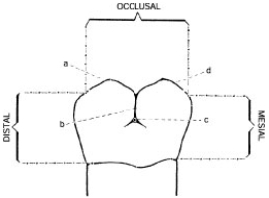
A) Mesiobuccal cusp
B) Buccal pit
C) Distobuccal cusp
D) Buccal groove

A) Mesiobuccal cusp
B) Buccal pit
C) Distobuccal cusp
D) Buccal groove
C
Structure "a" depicts the distobuccal cusp. Structure "b" depicts the buccal groove. Structure "c" depicts the buccal pit. Structure "d" depicts the mesiobuccal cusp. Note that this tooth has four cusps nearly equal in size. A single buccal groove separates the two buccal cusps and ends in the buccal pit.
Structure "a" depicts the distobuccal cusp. Structure "b" depicts the buccal groove. Structure "c" depicts the buccal pit. Structure "d" depicts the mesiobuccal cusp. Note that this tooth has four cusps nearly equal in size. A single buccal groove separates the two buccal cusps and ends in the buccal pit.
3
Below is an illustration of the buccal surface of a mandibular right second molar. Structure "c" depicts the 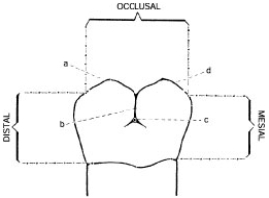
A) Mesiobuccal cusp
B) Buccal groove
C) Distobuccal groove
D) Buccal pit

A) Mesiobuccal cusp
B) Buccal groove
C) Distobuccal groove
D) Buccal pit
D
Structure "c" depicts the buccal pit. Structure "d" depicts the mesiobuccal cusp. Structure "a" depicts the distobuccal cusp. Structure "b" depicts the buccal groove. Note that this tooth has four cusps nearly equal in size. A single buccal groove separates the two buccal cusps and ends in the buccal pit.
Structure "c" depicts the buccal pit. Structure "d" depicts the mesiobuccal cusp. Structure "a" depicts the distobuccal cusp. Structure "b" depicts the buccal groove. Note that this tooth has four cusps nearly equal in size. A single buccal groove separates the two buccal cusps and ends in the buccal pit.
4
The root completion for the maxillary first molar is how many years of age?
A) 6
B) 8
C) 9 to 10
D) 11 to 12
A) 6
B) 8
C) 9 to 10
D) 11 to 12

Unlock Deck
Unlock for access to all 33 flashcards in this deck.
Unlock Deck
k this deck
5
Maxillary molars have an oblique ridge. The oblique ridge is a marginal ridge.
A) Both the statement and the reason are correct and related.
B) Both the statement and the reason are correct but are NOT related.
C) The statement is correct, but the reason is NOT correct.
D) The statement is NOT correct, but the reason is correct.
E) NEITHER the statement NOR the reason is correct.
A) Both the statement and the reason are correct and related.
B) Both the statement and the reason are correct but are NOT related.
C) The statement is correct, but the reason is NOT correct.
D) The statement is NOT correct, but the reason is correct.
E) NEITHER the statement NOR the reason is correct.

Unlock Deck
Unlock for access to all 33 flashcards in this deck.
Unlock Deck
k this deck
6
The distolingual cusp of a maxillary first molar is quite small and considered afunctional. This cusp occupies 10% of the lingual surface and the mesiolingual cusp occupies the remaining 90% of the lingual surface.
A) Both statements are true.
B) The first statement is true; the second is false.
C) The first statement is false; the second is true.
D) Both statements are false.
A) Both statements are true.
B) The first statement is true; the second is false.
C) The first statement is false; the second is true.
D) Both statements are false.

Unlock Deck
Unlock for access to all 33 flashcards in this deck.
Unlock Deck
k this deck
7
Which molar's occlusal groove pattern resembles a cross (+)?
A) Maxillary first
B) Maxillary second
C) Mandibular first
D) Mandibular second
A) Maxillary first
B) Maxillary second
C) Mandibular first
D) Mandibular second

Unlock Deck
Unlock for access to all 33 flashcards in this deck.
Unlock Deck
k this deck
8
All of the following terms are characteristic of maxillary third molars EXCEPT one. Which one is the EXCEPTION?
A) Congenitally missing
B) Impacted
C) Erupt between 18 and 25 years
D) Show variations of the crown or roots
A) Congenitally missing
B) Impacted
C) Erupt between 18 and 25 years
D) Show variations of the crown or roots

Unlock Deck
Unlock for access to all 33 flashcards in this deck.
Unlock Deck
k this deck
9
The oblique ridge, unique to the maxillary molars, is considered a transverse ridge because it runs in several directions.
A) Both the statement and the reason are correct and related.
B) Both the statement and the reason are correct but are NOT related.
C) The statement is correct, but the reason is NOT correct.
D) The statement is NOT correct, but the reason is correct.
E) NEITHER the statement NOR the reason is correct.
A) Both the statement and the reason are correct and related.
B) Both the statement and the reason are correct but are NOT related.
C) The statement is correct, but the reason is NOT correct.
D) The statement is NOT correct, but the reason is correct.
E) NEITHER the statement NOR the reason is correct.

Unlock Deck
Unlock for access to all 33 flashcards in this deck.
Unlock Deck
k this deck
10
The calcification of both maxillary and mandibular first molars is evident birth. The calcification of maxillary third molars is evident at 5 years whereas calcification of mandibular third molars is evident at 7 years.
A) Both statements are true.
B) The first statement is true; the second is false.
C) The first statement is false; the second is true.
D) Both statements are false.
A) Both statements are true.
B) The first statement is true; the second is false.
C) The first statement is false; the second is true.
D) Both statements are false.

Unlock Deck
Unlock for access to all 33 flashcards in this deck.
Unlock Deck
k this deck
11
Maxillary molars have at least four pulp horns. Mandibular molars have three pulp horns except for the third molars, which have four.
A) Both statements are true.
B) The first statement is true; the second is false.
C) The first statement is false; the second is true.
D) Both statements are false.
A) Both statements are true.
B) The first statement is true; the second is false.
C) The first statement is false; the second is true.
D) Both statements are false.

Unlock Deck
Unlock for access to all 33 flashcards in this deck.
Unlock Deck
k this deck
12
The mesial root of the mandibular first molar often has
A) One pulp canal
B) Two pulp canals
C) Two distinct mesial roots
D) Dilaceration
A) One pulp canal
B) Two pulp canals
C) Two distinct mesial roots
D) Dilaceration

Unlock Deck
Unlock for access to all 33 flashcards in this deck.
Unlock Deck
k this deck
13
Maxillary molars have sturdy anchorage because the two roots are connected to a single root trunk.
A) Both the statement and the reason are correct and related.
B) Both the statement and the reason are correct but are NOT related.
C) The statement is correct, but the reason is NOT correct.
D) The statement is NOT correct, but the reason is correct.
E) NEITHER the statement NOR the reason is correct.
A) Both the statement and the reason are correct and related.
B) Both the statement and the reason are correct but are NOT related.
C) The statement is correct, but the reason is NOT correct.
D) The statement is NOT correct, but the reason is correct.
E) NEITHER the statement NOR the reason is correct.

Unlock Deck
Unlock for access to all 33 flashcards in this deck.
Unlock Deck
k this deck
14
The distal contact area of the mandibular right first molar is located on the distal cusp. This contact area centered over the distal root.
A) Both statements are true.
B) The first statement is true; the second is false.
C) The first statement is false; the second is true.
D) Both statements are false.
A) Both statements are true.
B) The first statement is true; the second is false.
C) The first statement is false; the second is true.
D) Both statements are false.

Unlock Deck
Unlock for access to all 33 flashcards in this deck.
Unlock Deck
k this deck
15
Each of the following statements correctly describes maxillary molars EXCEPT one. Which one is the EXCEPTION?
A) Roots become shorter as the maxillary molar is more posterior.
B) Second molar roots are closer together than first molars.
C) Third molar roots are usually smaller than first or second molars.
D) First molar roots show the most variation in root form of all three molars.
A) Roots become shorter as the maxillary molar is more posterior.
B) Second molar roots are closer together than first molars.
C) Third molar roots are usually smaller than first or second molars.
D) First molar roots show the most variation in root form of all three molars.

Unlock Deck
Unlock for access to all 33 flashcards in this deck.
Unlock Deck
k this deck
16
Permanent maxillary first molars are classified as succedaneous teeth. They are generally the largest of the three molars.
A) Both statements are true.
B) The first statement is true; the second is false.
C) The first statement is false, the second is true.
D) Both statements are false.
A) Both statements are true.
B) The first statement is true; the second is false.
C) The first statement is false, the second is true.
D) Both statements are false.

Unlock Deck
Unlock for access to all 33 flashcards in this deck.
Unlock Deck
k this deck
17
Below is an illustration of the buccal surface of a mandibular right second molar. Structure "b" depicts the 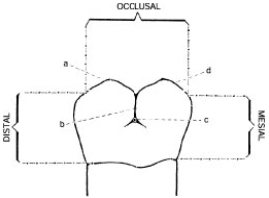
A) Buccal groove
B) Distobuccal cusp
C) Buccal pit
D) Mesiobuccal cusp

A) Buccal groove
B) Distobuccal cusp
C) Buccal pit
D) Mesiobuccal cusp

Unlock Deck
Unlock for access to all 33 flashcards in this deck.
Unlock Deck
k this deck
18
Compared with first molars, third molars most often have _____ roots.
A) More
B) Longer
C) Closer
D) Less defined
A) More
B) Longer
C) Closer
D) Less defined

Unlock Deck
Unlock for access to all 33 flashcards in this deck.
Unlock Deck
k this deck
19
Which of the following is true of mandibular first and second molars?
A) The two buccal cusps of both teeth are divided by a buccal groove.
B) Only the mandibular first molar has a buccal groove dividing the two buccal cusps.
C) Only the mandibular second molar has a buccal groove dividing the two buccal cusps.
D) Both mandibular first and second molars have a fifth cusp.
A) The two buccal cusps of both teeth are divided by a buccal groove.
B) Only the mandibular first molar has a buccal groove dividing the two buccal cusps.
C) Only the mandibular second molar has a buccal groove dividing the two buccal cusps.
D) Both mandibular first and second molars have a fifth cusp.

Unlock Deck
Unlock for access to all 33 flashcards in this deck.
Unlock Deck
k this deck
20
Maxillary and mandibular first molars have a fifth or supplemental cusp. This additional cusp, the cusp of Carabelli, is located on the mesiolingual cusp tip.
A) Both statements are true.
B) The first statement is true; the second is false.
C) The first statement is false; the second is true.
D) Both statements are false.
A) Both statements are true.
B) The first statement is true; the second is false.
C) The first statement is false; the second is true.
D) Both statements are false.

Unlock Deck
Unlock for access to all 33 flashcards in this deck.
Unlock Deck
k this deck
21
Below is an illustration of the buccal surface of a mandibular right second molar. Structure "d" depicts the 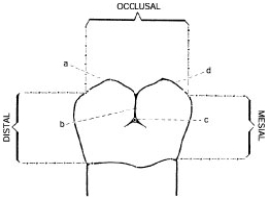
A) Distobuccal cusp
B) Mesiobuccal cusp
C) Buccal groove
D) Buccal pit

A) Distobuccal cusp
B) Mesiobuccal cusp
C) Buccal groove
D) Buccal pit

Unlock Deck
Unlock for access to all 33 flashcards in this deck.
Unlock Deck
k this deck
22
In the figure below, "b" represents the ____________.
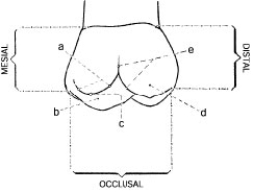


Unlock Deck
Unlock for access to all 33 flashcards in this deck.
Unlock Deck
k this deck
23
In the figure below, "c" represents the ____________.



Unlock Deck
Unlock for access to all 33 flashcards in this deck.
Unlock Deck
k this deck
24
Mandibular molars are wider mesiodistally than buccolingually.

Unlock Deck
Unlock for access to all 33 flashcards in this deck.
Unlock Deck
k this deck
25
Mrs. Garcia was upset after being informed that her 11-year-old son has areas of decay on two permanent second molars. Mrs. Garcia was certain that sealants had been placed on all of his molars "about one year ago." Which areas on the second molars would be the LEAST likely to develop decay?
A) Mesial pit
B) Distal pit
C) Buccal pit
D) Lingual pit
A) Mesial pit
B) Distal pit
C) Buccal pit
D) Lingual pit

Unlock Deck
Unlock for access to all 33 flashcards in this deck.
Unlock Deck
k this deck
26
In the figure below, "d" represents the ____________.
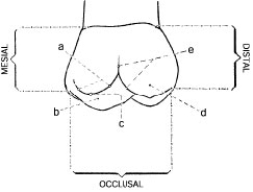


Unlock Deck
Unlock for access to all 33 flashcards in this deck.
Unlock Deck
k this deck
27
Mrs. Garcia was upset after being informed that her 11-year-old son has areas of decay on two permanent second molars. Mrs. Garcia was certain that sealants had been placed on all of his molars "about one year ago." Why would Mrs. Garcia be incorrect regarding the sealants being placed on her son's second molars?
A) The second molars probably had not erupted at that time.
B) Sealants were placed on the permanent first molars and may have been placed on deciduous molars too.
C) Sealants don't always prevent decay.
D) Mrs. Garcia is unaware of the eruption sequence.
A) The second molars probably had not erupted at that time.
B) Sealants were placed on the permanent first molars and may have been placed on deciduous molars too.
C) Sealants don't always prevent decay.
D) Mrs. Garcia is unaware of the eruption sequence.

Unlock Deck
Unlock for access to all 33 flashcards in this deck.
Unlock Deck
k this deck
28
Roots of the mandibular molars are inclined mesially.

Unlock Deck
Unlock for access to all 33 flashcards in this deck.
Unlock Deck
k this deck
29
Accessional is another term for nonsuccedaneous.

Unlock Deck
Unlock for access to all 33 flashcards in this deck.
Unlock Deck
k this deck
30
The mesiobuccal root is the longest root on maxillary first and second molars.

Unlock Deck
Unlock for access to all 33 flashcards in this deck.
Unlock Deck
k this deck
31
In the figure below, "e" represents the ____________.
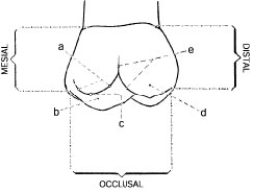


Unlock Deck
Unlock for access to all 33 flashcards in this deck.
Unlock Deck
k this deck
32
In the figure below, "a" represents the ____________.
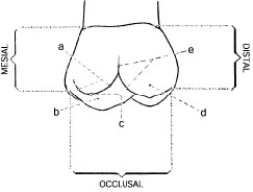


Unlock Deck
Unlock for access to all 33 flashcards in this deck.
Unlock Deck
k this deck
33
Match between columns

Unlock Deck
Unlock for access to all 33 flashcards in this deck.
Unlock Deck
k this deck



